
Homemade Pie Dough
Master the art of making Homemade Pie Dough with my easy-to-follow recipe. It's flaky, buttery, tender, and bakes beautifully every single time! My recipe makes a nice thick crust, and I'm sharing what you need to make a Single Crust or a Double Crust.
Ingredients
Single Pie Crust
- 1 2/3 cups all-purpose flour, spooned and leveled
- 1 Tbsp. granulated sugar (optional)
- 3/4 tsp. salt
- 6 Tbsp. vegetable shortening, cold, cut into pieces
- 6 Tbsp. unsalted butter, cold, cut into pieces
- 1/3 cup ice cold water, you may not need all of it
Double Pie Crust
- 3 cups all-purpose flour, spooned and leveled
- 2 Tbsp. granulated sugar (optional)
- 1 1/2 tsp. salt
- 8 Tbsp. vegetable shortening, cold, cut into pieces
- 8 Tbsp. unsalted butter, cold, cut into pieces
- 2/3 cup ice cold water, you may not need all of it
Instructions
- Note: this recipe can make one single crust, or you can make a double crust if you need a top crust or for a lattice. Keep in mind when you divide the dough into 2 disks in Step 7, the bottom crust should be a little larger than the top crust. This is because the top crust only needs to cover the surface of the filling. But the bottom crust needs to hold all the filling. OR you can just divide it into 2 equal portion if you want 2 single pie crusts. 🤗
- Add a few ice cubes into a measuring cup and fill it with just about ⅓ cup of water. You won’t use all the water, about 1/4 cup is necessary. Set aside.
- Combine the flour, sugar (if using), and salt in a large mixing bowl.1 2/3 cups all-purpose flour, spooned and leveled, 1 Tbsp. granulated sugar (optional), 3/4 tsp. salt
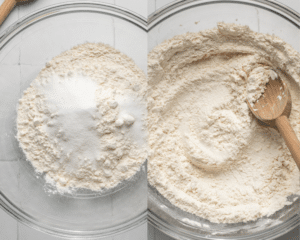
- Add the small pieces of shortening and small pieces of butter into the flour. Cut in with a pastry blender until you get pea-sized bits and almond-sized bits of flour throughout the mixture.6 Tbsp. vegetable shortening, cold, cut into pieces, 6 Tbsp. unsalted butter, cold, cut into pieces

- Drizzle in 1 Tbsp. of the ice-cold water at a time, mixing and adding another tablespoon of water at a time to moisten everything. It will still be a bit crumbly and shaggy. You don’t want to add too much water because it will take away the crisp crust factor. You'll know you've added enough water when you can squeeze it together with your fingers.1/3 cup ice cold water, you may not need all of it

- Turn the crumbly dough out onto a lightly floured surface. Gather it into a ball and start to press it together. Fold the dough over itself a few times to create those buttery layers, being careful not to overwork the dough. We’re not kneading it here, more of a folding motion to bring it into a ball. Pro tip: if you've already added all the water but it still feels dry, add a little water into a spray bottle to spritz the dough with water if there are dry spots to help you control how much water you add to the dough.

- Press it into a 1-inch disk (or even a little less than 1 inch) with smooth edges and tightly wrap it in plastic wrap. (Here is where you can divide it into 2 disks if making the double crust). Chill in the fridge for at least 1 hour or up to 3 days.

- Remove the dough from the fridge and place it on the counter for 5-10 minutes to slightly warm up before rolling it out. If you roll it out straight from the fridge, the edges may crack.
- Lightly flour a clean work surface and a rolling pin. Lightly flour both sides of the dough and gently press it into a large circle, starting at the center and working out. Keep the dough moving, lifting, turning, rotating, and flipping so it doesn’t stick. Re-flour the rolling pin as needed and roll it into about a 12-inch circle.
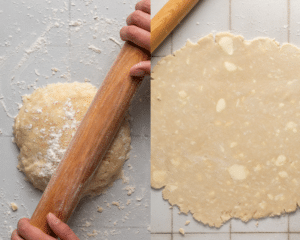
- Transfer the dough by carefully rolling it around your rolling pin, using a bench scraper to help lift it off the work surface if needed. Unroll it over a 9-inch pie plate, gently easing it into the pan to settle it down, rather than pressing it down.
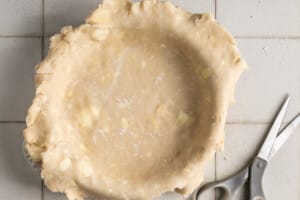
- You can trim any really long bits of pie dough that may be hanging over, and fold the other hanging parts of pie dough under itself to strengthen the crust into a thick, sturdy crust.
- Flute/crimp the edges of the dough: you can use the forefinger of one hand and the thumb and forefingers of your other hand or I also like to use both forefingers and the thumb of one hand (see video).
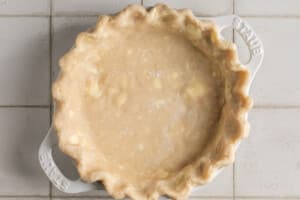
- Place back in the freezer for at least 30 minutes to chill again. This last chill seals in the crimp pattern and really ensures the dough is cold. From here you can fill with desired pie filling or follow next steps if you need a baked pie shell.
Blind Bake/Par-Bake Instructions:
- Preheat the oven to 375°F. Crunch up a piece of parchment paper or piece of foil and open it back up. Place it onto the unbaked pie crust. Pour pie weights (or dried beans) on top of the parchment paper and push the pie weights all along the center and sides. You’ll need enough pie weights to fill it, I usually use 2 packs. Place on a rimmed baking sheet. (This just makes it easier to take in and out of the oven so the oven mitts don’t touch the crust).

- Partially baked pie crust: Bake for 10-15 minutes or until the edges get golden. Remove from the oven and carefully lift the parchment/foil and pie weights, and set aside. Using a fork, poke holes all over the bottom of the pastry dough. Shield the edges of the pie dough with a pie shield or foil and place bake in the oven for 7-8 more minutes or until crust appears dry. The crust will be partially baked at this point.
- Fully baked pie crust: If you need a fully baked pie crust, bake for 10-15 minutes more or until the crust is golden brown.
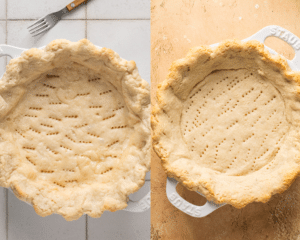
Video
Notes
- Make ahead: the pie dough may be prepared, wrapped tightly in plastic wrap, and refrigerated for up to 3 days. When you're ready to roll out, be sure to allow it to sit at room temperature for 10ish minutes before rolling so the edges don't crack.
- To freeze the dough: you can make the recipe all the way to step 6. Tightly wrap the disk in plastic wrap and place in a freezer safe baggie. When ready to use the dough, thaw overnight in the fridge.
- Food processor: to make this in a food processor, blitz the dry ingredients together. Then pulse in the shortening and butter. Slowly drizzle in the cold water until the dough starts to stick together, but it will still look a bit shaggy. Turn the dough out onto a clean work surface, and repeat the same steps starting at Step 6.